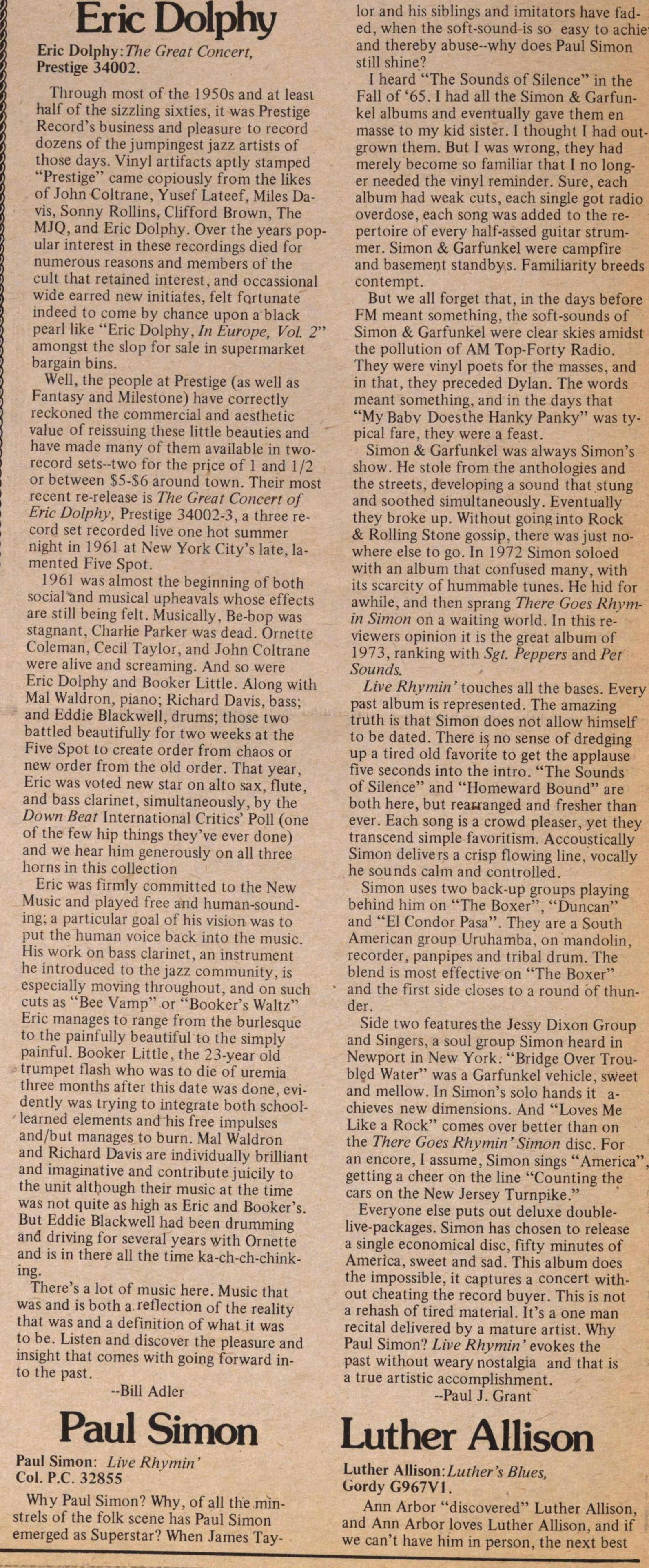Paul Simon

Paul Simon: Live Rhymin'
Col. P.C. 32855
Why Paul Simon? Why, of all the minstrels of the folk scene has Paul Simon emerged as Superstar? When James Taylor and his siblings and imitators have faded, when the soft-sound is so easy to achieve and thereby abuse--why does Paul Simon still shine?
I heard "The Sounds of Silence" in the Fall of '65. I had all the Simon & Garfunkel albums and eventually gave them en masse to my kid sister. I thought I had outgrown them. But I was wrong, they had merely become so familiar that I no longer needed the vinyl reminder. Sure, each album had weak cuts, each single got radio overdose, each song was added to the repertoire of every half-assed guitar strummer. Simon & Garfunkel were campfire and basement standbys. Familiarity breeds contempt.
But we all forget that, in the days before FM meant something, the soft-sounds of Simon & Garfunkel were clear skies amidst the pollution of AM Top-Forty Radio. They were vinyl poets for the masses, and in that, they preceded Dylan. The words meant something, and in the days that "My Baby Does the Hanky Panky" was typical fare, they were a feast.
Simon & Garfunkel was always Simon's show. He stole from the anthologies and the streets, developing a sound that stung and soothed simultaneously. Eventually they broke up. Without going into Rock & Rolling Stone gossip, there was just nowhere else to go. In 1972 Simon soloed with an album that confused many, with its scarcity of hummable tunes. He hid for awhile, and then sprang There Goes Rhymin Simon on a waiting world. In this reviewers opinion it is the great album of 1973, ranking with Sgt. Peppers and Pet Sounds.
Live Rhymin' touches all the bases. Every past album is represented. The amazing truth is that Simon does not allow himself to be dated. There is no sense of dredging up a tired old favorite to get the applause five seconds into the intro. "The Sounds of Silence" and "Homeward Bound" are both here, but rearranged and fresher than ever. Each song is a crowd pleaser, yet they transcend simple favoritism. Acoustically Simon delivers a crisp flowing line, vocally he sounds calm and controlled.
Simon uses two back-up groups playing behind him on "The Boxer", "Duncan" and "El Condor Pasa". They are a South American group Uruhamba, on mandolin, recorder, panpipes and tribal drum. The blend is most effective on "The Boxer" and the first side closes to a round of thunder.
Side two features the Jessy Dixon Group and Singers, a soul group Simon heard in Newport in New York. "Bridge Over Troubled Water" was a Garfunkel vehicle, sweet and mellow. In Simon's solo hands it achieves new dimensions. And "Loves Me Like a Rock" comes over better than on the There Goes Rhymin' Simon disc. For an encore, I assume, Simon sings "America", getting a cheer on the line "Counting the cars on the New Jersey Turnpike."
Everyone else puts out deluxe double-live-packages. Simon has chosen to release a single economical disc, fifty minutes of America, sweet and sad. This album does the impossible, it captures a concert without cheating the record buyer. This is not a rehash of tired material. It's a one man recital delivered by a mature artist. Why Paul Simon? Live Rhymin' evokes the past without weary nostalgia and that is a true artistic accomplishment.
-Paul J. Grant
Article
Subjects
Freeing John Sinclair
Old News
Ann Arbor Sun